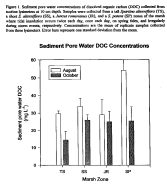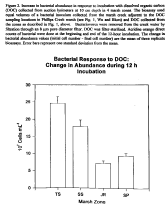EFFECTS OF INUNDATION FREQUENCY ON THE RELATIVE SUSCEPTIBILITY
OF SEDIMENT PORE WATER DISSOLVED ORGANIC MATERIAL TO
METABOLISM BY MICROORGANISMS
Jennifer D. Aiosa and Linda K. Blum,
Laboratory of Microbial Ecology,
University of Virginia
Coastal salt marshes like those at the VCR LTER are geologically young
formations and experience rapid change. Changes in sea level trigger systematic
hydrologic and ecologic response characterized by the migration of marsh zones
coinciding with increased inundation. As areas of marsh experience increased
flooding, the vegetation characteristic to low, mid, and high marsh zones also
migrate in response to the change. Along with the obvious changes in plant
species as marshland migrates into upland areas, less obvious changes in the
organic matter content of the sediments also occurs. The low organic matter
content upland soils give rise to high organic matter content high marsh
sediments which in turn give rise to low organic matter content low marsh
sediments. These changes in sediment organic matter content may be directly
attributed to altered patterns of tidal flooding frequency or may be related to
differences in the susceptibility of each zone's characteristic vegetation
to decay.
Microbial mineralization of organic matter consists of the conversion of
particulate organic carbon to dissolved organic carbon (DOC), a form
assimilated and metabolized by microbial cells. Therefore, the quantity and
quality of DOC in sediment pore water may be an indicator of the rate of the
susceptibility of sediment organic matter to mineralization or burial. For
example, low concentrations of labile DOC would suggest rapid turnover of DOC
and organic material mineralization, while high concentrations of refractory
DOC would indicate slow turnover, long residence times, and the potential for
organic material accumulation. Preliminary observations of sediment pore water
DOC concentrations and the ability of bacteria to convert the DOC to cell
biomass in four vegetation types representing a tidal inundation gradient in
areas of the Phillips Creek Marsh suggest the following: i.) sediment pore
water concentrations increase as inundation frequency decreases (Fig. 1) and
ii.) that DOC in frequently flooded sediments is more readily converted to
bacterial biomass than in less frequently flooded sediments (Fig. 2).
During the summer of 1995, experiments will be conducted to determine if the
differences in DOC concentration and conversion of DOC to bacterial cells is a
result of differences in tidal inundation frequency, the type of plant
materials characteristic of the four marsh zones, or a combination of both
inundation frequency and type of organic material.
 Figure 1. Sediment pore water concentrations of dissolved organic carbon (DOC)
collected from suction lysimeters at 10 cm depth. Samples were collected from a
tall Spartina alterniflora (TS), a short S. alterniflora
(SS), a Juncus romerianus (JR), and a S. patens (SP) zones
of the marsh where tidal inundation occurs twice each day, once each day, on
spring tides, and irregularly during storm events, respectively. Concentrations
are the mean of replicate samples collected from three lysimeters. Error bars
represent one standard deviation from the mean.
Figure 1. Sediment pore water concentrations of dissolved organic carbon (DOC)
collected from suction lysimeters at 10 cm depth. Samples were collected from a
tall Spartina alterniflora (TS), a short S. alterniflora
(SS), a Juncus romerianus (JR), and a S. patens (SP) zones
of the marsh where tidal inundation occurs twice each day, once each day, on
spring tides, and irregularly during storm events, respectively. Concentrations
are the mean of replicate samples collected from three lysimeters. Error bars
represent one standard deviation from the mean.
Click here for Picture
 Figure 2. Increase in bacterial abundance in response to incubation with
dissolved organic carbon (DOC) collected from suction lysimeters at 10 cm depth
in 4 marsh zones. The bioassay used equal volumes of a bacterial inoculum
collected from the marsh creek adjacent to the DOC sampling locations in
Phillips Creek marsh (see Fig. 1, Wu and Blum) and DOC collected from the zones
as described in Fig. 1, above. Bacteriovores were removed from the creek
water by filtration through an 8 um pore diameter filter. DOC was
filter-sterilized. Acridine orange direct counts of bacterial were done at the
beginning and end of the 12-hour incubation. The change in bacterial abundance
values (initial cell number - final cell number) are the mean of three
replicate bioassays. Error bars represent one standard deviation from the
mean.
Figure 2. Increase in bacterial abundance in response to incubation with
dissolved organic carbon (DOC) collected from suction lysimeters at 10 cm depth
in 4 marsh zones. The bioassay used equal volumes of a bacterial inoculum
collected from the marsh creek adjacent to the DOC sampling locations in
Phillips Creek marsh (see Fig. 1, Wu and Blum) and DOC collected from the zones
as described in Fig. 1, above. Bacteriovores were removed from the creek
water by filtration through an 8 um pore diameter filter. DOC was
filter-sterilized. Acridine orange direct counts of bacterial were done at the
beginning and end of the 12-hour incubation. The change in bacterial abundance
values (initial cell number - final cell number) are the mean of three
replicate bioassays. Error bars represent one standard deviation from the
mean.
Click here for Picture
This work is a result of research sponsored in part by NOAA Office of Sea
Grant, U.S. Department of Commerce, under Grant No. NA90AA-D-SG045 to the
Virginia Graduate Marine Science Corsortium and Virginia Sea Grant College
Program. The U.S. Government is authorized to produce and distribute reprints
for governmental purposes notwithstanding any copyright notataion that may
appear hereon.
 Figure 1. Sediment pore water concentrations of dissolved organic carbon (DOC)
collected from suction lysimeters at 10 cm depth. Samples were collected from a
tall Spartina alterniflora (TS), a short S. alterniflora
(SS), a Juncus romerianus (JR), and a S. patens (SP) zones
of the marsh where tidal inundation occurs twice each day, once each day, on
spring tides, and irregularly during storm events, respectively. Concentrations
are the mean of replicate samples collected from three lysimeters. Error bars
represent one standard deviation from the mean.
Figure 1. Sediment pore water concentrations of dissolved organic carbon (DOC)
collected from suction lysimeters at 10 cm depth. Samples were collected from a
tall Spartina alterniflora (TS), a short S. alterniflora
(SS), a Juncus romerianus (JR), and a S. patens (SP) zones
of the marsh where tidal inundation occurs twice each day, once each day, on
spring tides, and irregularly during storm events, respectively. Concentrations
are the mean of replicate samples collected from three lysimeters. Error bars
represent one standard deviation from the mean.